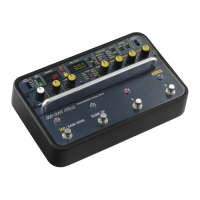11
1. FEEDBACK
knob
2. INV button
3. FILTER button
7. REGENERATION
1. FEEDBACK knob
Use this knob to set the number
of times that the delay sound
will be repeated (feedback).
2. INV button
Press this buon to invert the
phase of the delay sound.
The tone can be signicantly
changed if the delay sound is
added to the input signal with
an inverted phase and feedback
is applied to a short delay, such
as anging, in particular. When
the inverter is turned on, the
LED lights up.
3. FILTER button
You can change the sound
quality of the signal (delay
sound) that passes through
delay modulation. The feedback
eect on the signal passing
through the lter will increase as
the feedback amount (number
of times repeated) is increased.
8. MODULATION
1. WAVEFORM knob
Use this knob to switch the
waveform. This determines the
waveform for modulating the
delay time, the panning phase,
the variable amount of pitch
shi, etc.
Seing the knob between two
waveforms creates a waveform
that combines the two. By
changing the knob seing, you
can obtain various eects, such
as natural or complex.
(Sine): Use this waveform
for eects like chorus, vibrato
and anging.
(Triangle): Use this waveform
in the same various applications
as with Sine.
(Square): Use this waveform
to combine special eects, such
as a repeating eect with dier-
ent pitches.
RND (Random): This irregularly
changes
the delay time.
Use this
waveform
for the wow and ut-
ter eect of a tape echo.
ENV (Envelope): The delay
time can be varied according to
the envelope (volume change)
of the sound being input. Use
1. WAVEFORM knob 2. INTENSITY knob
3. FREQUENCY knob
this waveform for the Doppler
eect, for example.

